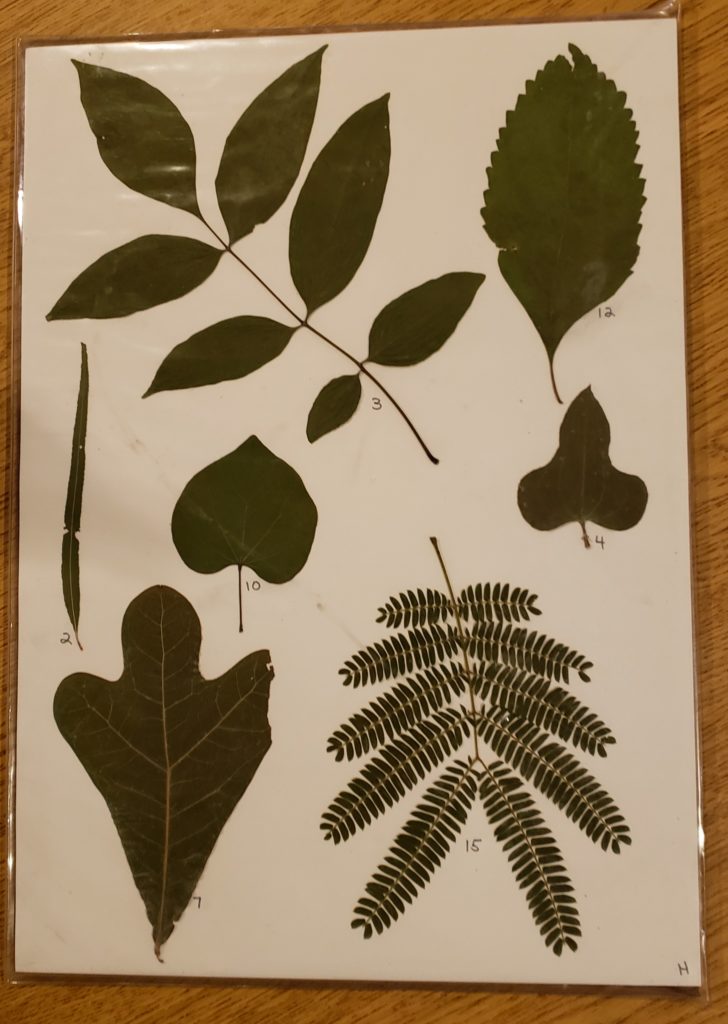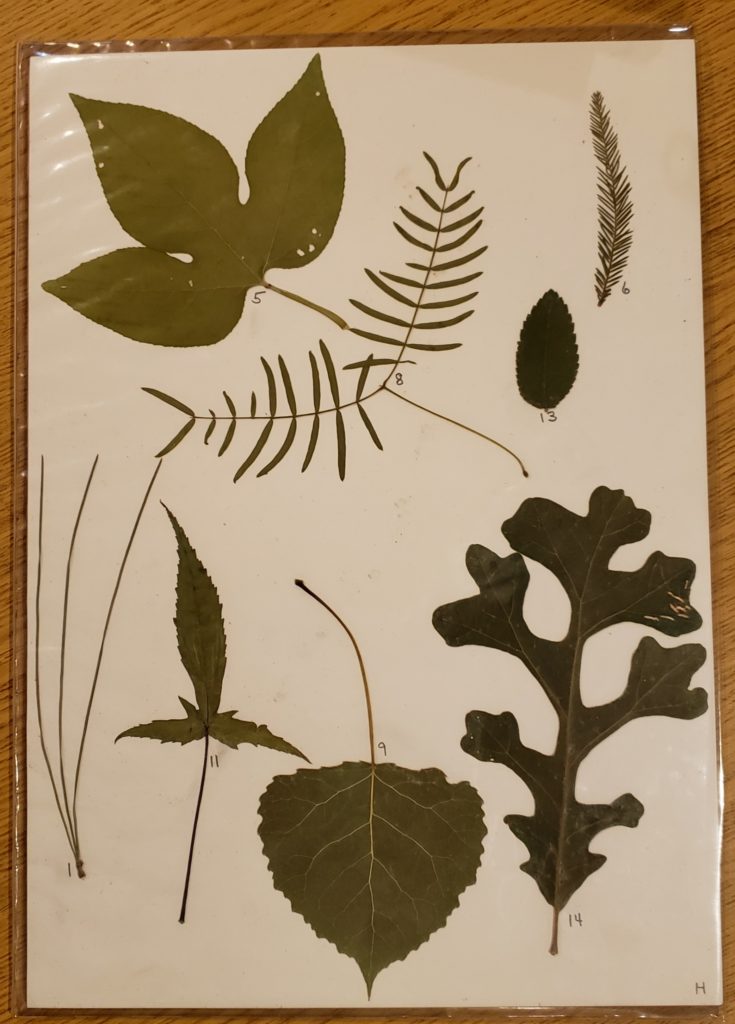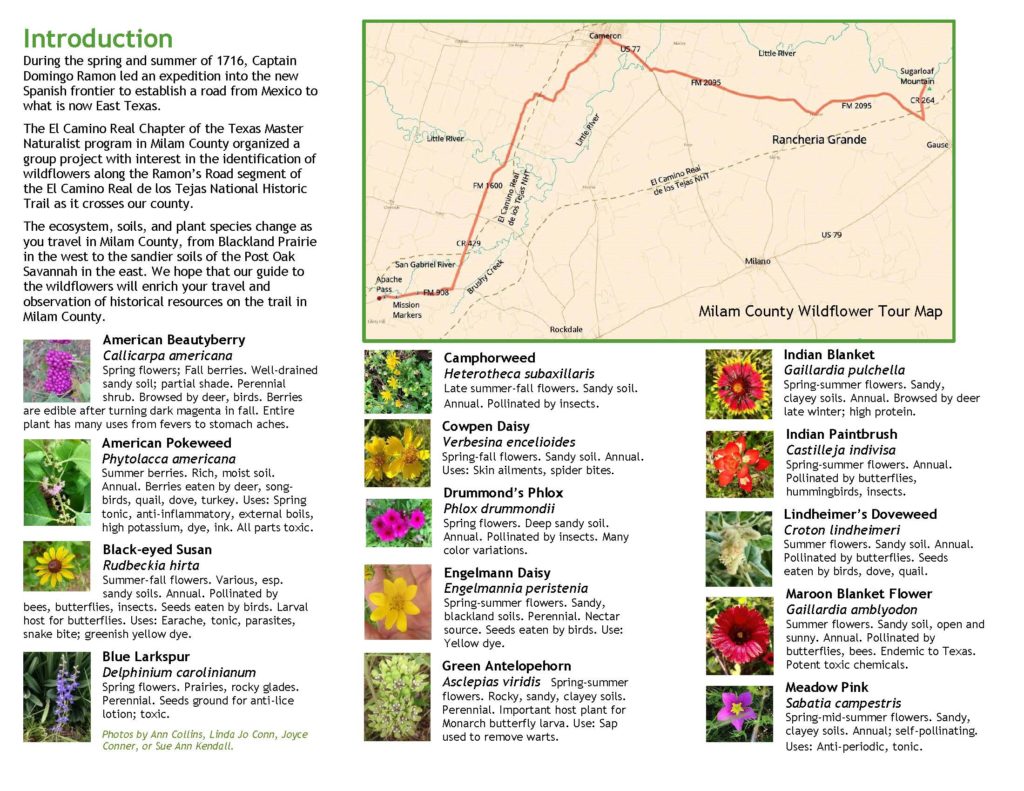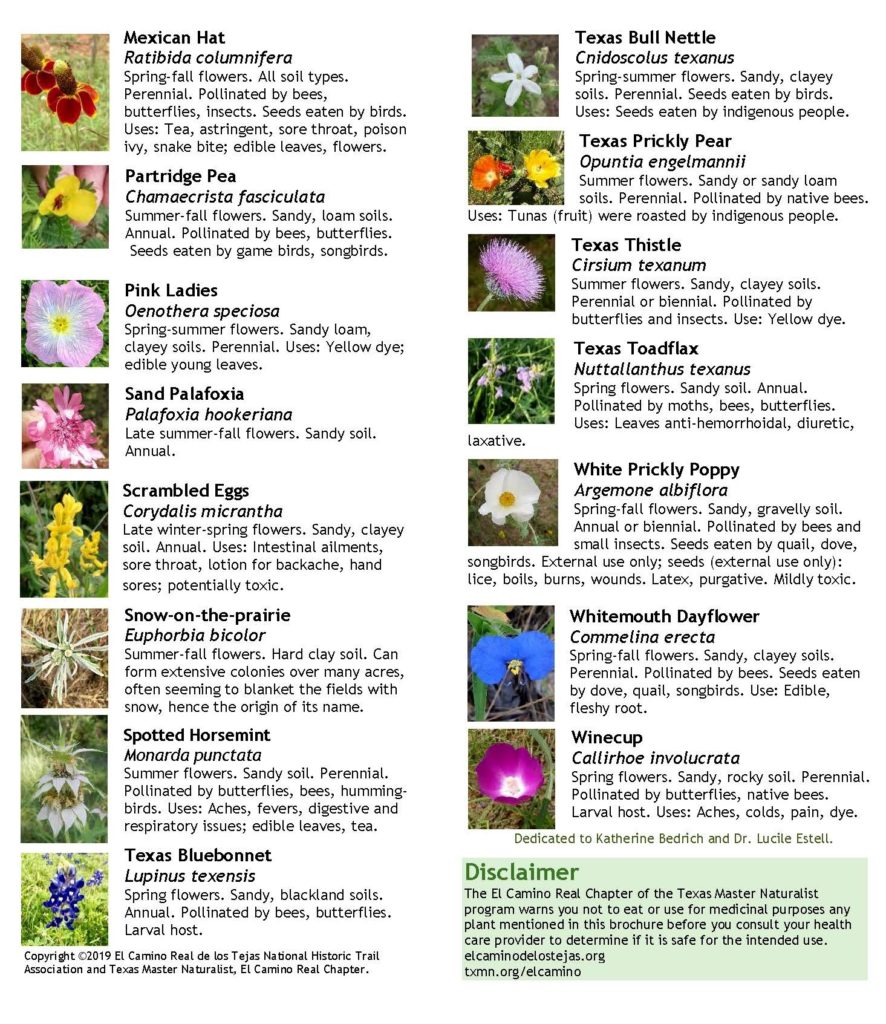Botany – Plants, Flowers, Grass and Rangelands, Bryophytes, and Algae / Fungi / Lichen
(For Trees, see the section Forests and Woodlands.)
This page has four major sections:
1. Definitions
2. Class and Advanced Training Presentations
3. Web sites, References, Articles and Books of interest
4. Shawn Walton’s weekly blog / columns in Rockdale and Cameron Newspapers
1. Definitions:
Botany
From Wikipedia:
Botany, plant science(s), phytology, or plant biology is a branch of biology and is the scientific study of plant life and development. Botany covers a wide range of scientific disciplines that study plants, algae, and fungi including: structure, growth, reproduction, metabolism, development, diseases, and chemical properties and evolutionary relationships between the different groups. Botany, the study of plants, began with tribal efforts to identify edible, medicinal and poisonous plants, making botany one of the oldest sciences. From this ancient interest in plants, the scope of botany has increased to include the study of over 550,000 kinds or species of living organisms.
Plants
From Wikipedia:
Plants are living organisms belonging to the kingdom Plantae. They include familiar organisms such as trees, herbs, bushes, grasses, vines, ferns, mosses, and green algae. About 350,000 species of plants, defined as seed plants, bryophytes, ferns and fern allies, are estimated to exist currently. As of 2004, some 287,655 species had been identified, of which 258,650 are flowering and 18,000 bryophytes (see table below). Green plants, sometimes called metaphytes or viridiplantae, obtain most of their energy from sunlight via a process called photosynthesis.
Flowers
From Wikipedia:
A flower, sometimes known as a bloom or blossom, is the reproductive structure found in flowering plants (plants of the division Magnoliophyta, also called angiosperms). The biological function of a flower is to mediate the union of male sperm with female ovum in order to produce seeds. The process begins with pollination, is followed by fertilization, leading to the formation and dispersal of the seeds. For the higher plants, seeds are the next generation, and serve as the primary means by which individuals of a species are dispersed across the landscape. The grouping of flowers on a plant are called the inflorescence.
In addition to serving as the reproductive organs of flowering plants, flowers have long been admired and used by humans, mainly to beautify their environment but also as a source of food.
Grasslands, Rangelands
From Wikipedia:
Grass and Grasslands: The appearance of mountains in the western United States during the Miocene and Pliocene epochs, a period of some 25 million years, created a continental climate favorable to the evolution of grasslands. Existing forest biomes declined, and grasslands became much more widespread. Following the Pleistocene Ice Ages, grasslands expanded in range in the hotter, drier climates, and began to become the dominant land feature worldwide.
As flowering plants, grasses grow in great concentrations in climates where annual rainfall ranges between approximately 20 to 35 inches. The root systems of perennial grasses and forbs form complex mats that hold the soil in place. Mites, insect larvae, nematodes and earthworms inhabit deep soil, which can reach about 20 feet underground in undisturbed grasslands on the richest soils of the world. These invertebrates, along with symbiotic fungi, extend the root systems, break apart hard soil, enrich it with urea and other natural fertilizers, trap minerals and water and promote growth (Chadwick 1995). Some types of fungi make the plants more resistant to insect and microbial attacks.
Rangeland refers to expansive, mostly unimproved lands on which a significant proportion of the natural vegetation is native grasses, grass-like plants, forbs, and shrubs. Rangeland also consists of areas seeded to native or adapted introduced species that are managed like native vegetation. Rangelands include natural grasslands, savannas, shrublands, many deserts, tundra, alpine communities, coastal marshes, and wet meadows. Rangeland is generally arid, semi-arid, sub-humid or otherwise unsuitable for cultivation. Ranches are likely to be mainly comprised of rangeland.
In the United States, around 399 million acres of rangeland are privately owned. The Bureau of Land Management manages about 167 million acres of publicly owned rangeland, with the United States Forest Service managing approximately 95 million acres more. Ranchers may lease portions of this public rangeland and pay a fee based on the number and type of livestock and the period for which they are on the land. Many western states have open range laws. In these states, all land, both public and private, is designated as open range unless it is within city limits. In open range, it becomes the responsibility of the land owner to keep unwanted livestock off their land and the livestock owner is not liable for any damage caused by the livestock.
Bryophytes – Hornworts, Liverworts, and Mosses
From Wikipedia:
Bryophytes are all embryophytes (‘land plants’) that are non-vascular: they have tissues and enclosed reproductive systems, but they lack vascular tissue that circulates liquids. They neither have flowers nor produce seeds, reproducing via spores. The term bryophyte comes from Greek βρύον – bryon, “tree-moss, oyster-green” + φυτόν – fyton “plant”.
The bryophytes (or non-tracheophytes) do not form a monophyletic group but consist of three groups, the Marchantiophyta (liverworts), Anthocerotophyta (hornworts), and Bryophyta (mosses). Originally the three groups were brought together as the three classes of division Bryophyta. However, since the three groups of bryophytes form a paraphyletic group, they now are placed in three separate divisions.
These plants are generally gametophyte-oriented; that is, the normal plant is the haploid gametophyte, with the only diploid structure being the sporangium in season. As a result, bryophyte sexuality is very different from that of other plants. There are two basic categories of sexuality in bryophytes:
Dioicous bryophytes produce only antheridia (male organs) or archegonia (female organs) on a single plant body.
Monoicous bryophytes produce both antheridia and archegonia on the same plant body.
Some bryophyte species may be either monoicous or dioicous depending on environmental conditions. Other species grow exclusively with one type of sexuality.
Notice that these terms are not the same as monoecious and dioecious, which refer to whether or not a sporophyte plant bears one or both kinds of gametophyte. Those terms apply only to seed plants.
Dispersal in bryophytes is via spores; they neither have flowers nor produce seeds. Bryophytes do produce gametes that fuse to form a zygote, which in turn develops into an embryo, but this is not contained in a seed as in gymnosperms and angiosperms.
Algae, Fungi, Lichen
From Wikipedia:
Algae (a Latin plural) are a large and diverse paraphyletic group of simple, typically autotrophic organisms, ranging from unicellular to multicellular forms. The largest and most complex marine forms are called seaweeds. They are photosynthetic, like plants, and “simple” because they lack the many distinct organs found in land plants. For that reason they are currently excluded from being considered plants.
Though the prokaryotic cyanobacteria (commonly referred to as blue-green algae) were traditionally included as “algae” in older textbooks, many modern sources regard this as outdated and restrict the term algae to eukaryotic organisms. All true algae therefore have a nucleus enclosed within a membrane and chloroplasts bound in one or more membranes. Algae constitute a paraphyletic and polyphyletic group, as they do not all descend from a common algal ancestor, although their chloroplasts seem to have a single origin.
Algae lack the various structures that characterize land plants, such as phyllids and rhizoids in nonvascular plants, or leaves, roots, and other organs that are found in tracheophytes. Many are photoautotrophic, although some groups contain members that are mixotrophic, deriving energy both from photosynthesis and uptake of organic carbon either by osmotrophy, myzotrophy, or phagotrophy. Some unicellular species rely entirely on external energy sources and have limited or no photosynthetic apparatus.
All algae have photosynthetic machinery ultimately derived from the cyanobacteria, and so produce oxygen as a by-product of photosynthesis, unlike other photosynthetic bacteria such as purple and green sulfur bacteria.
A fungus is a eukaryotic organism that is a member of the kingdom Fungi. The fungi are heterotrophic organisms possessing a chitinous cell wall. The majority of species grow as multicellular filaments called hyphae forming a mycelium; some fungal species also grow as single cells. Sexual and asexual reproduction of the fungi is commonly via spores, often produced on specialized structures or in fruiting bodies. Some species have lost the ability to form reproductive structures, and propagate solely by vegetative growth. Yeasts, molds, and mushrooms are examples of fungi. The fungi are a monophyletic group that is phylogenetically clearly distinct from the morphologically similar slime molds (myxomycetes) and water molds (oomycetes). The fungi are more closely related to animals than plants, yet the discipline of biology devoted to the study of fungi, known as mycology, often falls under a branch of botany.
Occurring worldwide, most fungi are largely invisible to the naked eye, living for the most part in soil, dead matter, and as symbionts of plants, animals, or other fungi. They perform an essential role in all ecosystems in decomposing organic matter and are indispensable in nutrient cycling and exchange. Some fungi become noticeable when fruiting, either as mushrooms or molds. Many fungal species have long been used as a direct source of food, such as mushrooms and truffles and in fermentation of various food products, such as wine, beer, and soy sauce. More recently, fungi are being used as sources for antibiotics used in medicine and various enzymes, such as cellulases, pectinases, and proteases, important for industrial use or as active ingredients of detergents. Many fungi produce bioactive compounds called mycotoxins, such as alkaloids and polyketides that are toxic to animals including humans. Some fungi are used recreationally or in traditional ceremonies as a source of psychotropic compounds. Several species of the fungi are significant pathogens of humans and other animals, and losses due to diseases of crops (e.g., rice blast disease) or food spoilage caused by fungi can have a large impact on human food supply and local economies.
Lichens are symbiotic associations of a fungus with a photosynthetic partner that can produce food for the lichen from sunlight. The photobiont is usually either a green alga or cyanobacterium. A few lichens are known to contain yellow-green algae or, in one case, a brown alga. Lichens are often the first to settle in places lacking soil, constituting the sole vegetation in some extreme environments such as those found at high mountain elevations and at high latitudes.
2. Class and Advanced Training Presentations
2008-2009 Class – Botany, Dr. Flo Oxley
2012 Class – Botany, Flo Oxley
- Botanically Speaking pdf file
- The Nature of Naming – Flo Oxley PPT file, The Nature of Naming – Flo Oxley PDF file
- Keys pdf file
2020 Class 0n Plant Identification and Keying, by Dale Kruse, Texas A&M S.M. Tracy Herbarium
- Plant Identification – ECRMN Dale Kruse 2/27/20 class – “The Importance and Practice of Plant ID” has been saved on our “Member’s Only” password protected page at Dale’s request because it has some photos and other information that is not to be shared on open websites. It is an AMAZING 87 page presentation and is most valuable to our members.
- Keying Identification exercise – see last three pages in above file, and use these:
- Two keying methods using Common Leaves PDF of handouts in class showing correct keying using two methods on these plants.
- Two placards of leaves for keying exercise
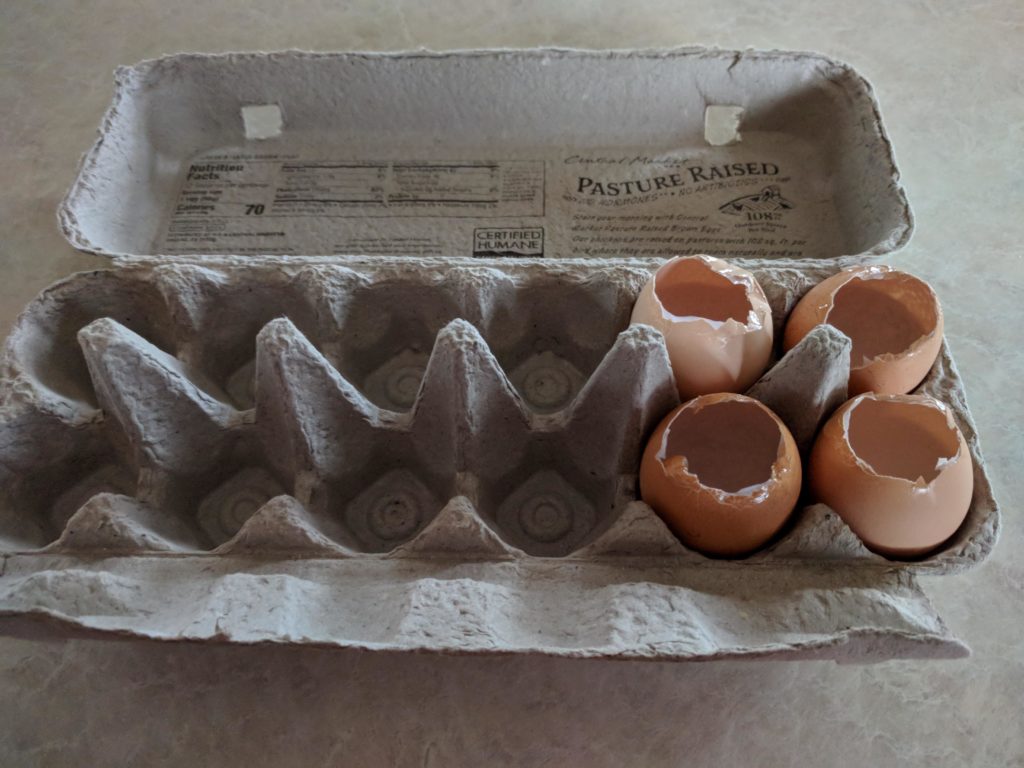 Making Egg Shell Planters by Kathy Lester, Egg Shell Planters PDF file
Making Egg Shell Planters by Kathy Lester, Egg Shell Planters PDF file
Wildflower Legends and Folklore: By Flo Oxley, Director of Conservation and Education, Lady Bird Johnson Wildflower Center, held at Rockdale General Store Feb. 11, 2009 and Cameron Chamber of Commerce Apr 1, 2009
- Wildflower Legends and Folklore
- Wildflower Legends and Folkore pictures and stories a complete tutorial
Sex in Your Garden by Flo Oxley – download presentation
Abbreviated sex in the garden PDF, May 24, 2013
Texas Mycology is Better Than Yours, PDF all about fungi and mushrooms, etc.
Hypersensitivity Reactions: Don’t touch the poison ivy, John Pruett
“The Cycle of Foraging” presentation by Sean Wall, April 12, 2018. Eating what nature provides. See his blog at aNaturalPlace.wordpress.com
Lessons from Arundo Control Man, AT presentation by Phyllis Shuffield at chapter meeting Jan 11, 2018, regarding the invasive Arundo (Giant Reed) included an overview presentation, a complete description of the problem and what we can do, a handout brochure available here, and an educational video available here. Also visit AquaPlant.tamu.edu.
Apr. 1, 2009 training session at Cameron Chamber of Commerce
- Light spectrum chart of colors and wavelengths.
- Chart of which pollinators can see various wavelengths.
- Bryophyte Adv. Training with Dale Kruse, Nov 7, 2009
Earthkind: Native and Poisonous Plants, Milano, Nov 5, 2009
Presentation 1: Pictures of poisonous plants, by Judy Schafer. This folder contains photos and a directory list for the photo file names vs plant names. The directory does not quite match the photos towards the end, as there are additional photos included. It also has a Picasa .ini file in the folder so if you use Picasa you will see any edits that were made by the author. Sort the photo folder by filename to see them in order 1 to n.
Access the Poison Plants folder on our chapter Drive
Presentation 2: Gardening with Native Plants, by Susan Williams.
From Sept. 22, 2008 Field Trip w/Ed Voss
Download Plant Identification Handout
March 8, 2018 Plants for Pollinators, by Cheryl Lewis, a neat website to find plants that Butterflies and Moths use, search either by plant or tree, or by the butterfly or moth, and keep your own list: Native Plant Finder by Dr. Doug Tallamy, National Wildlife Foundation.
Along the El Camino Real Trail – Wildflowers of Milam County Texas
By John Pruett: “During the Spring and Summer of 1716, Captain Domingo Ramon, led an expedition into the new Spanish frontier to establish a road from Mexico to what is now East Texas. The El Camino Real Master Naturalist Chapter of Milam County, Texas, organized a group project with interest in the identification of wildflowers along the Ramon’s Road segment of the El Camino de los Tejas National Historic Trail as it crosses our County. The ecosystem, soils, and plant species change as you travel in Milam County, from Blackland Prairie in the west to the sandier soils of the Post Oak Savannah in the east. We hope that our guide to the wildflowers will enrich your travel and observation of historical resources on the El Camino in Milam County.“
Full color glossy brochure available from any chapter member.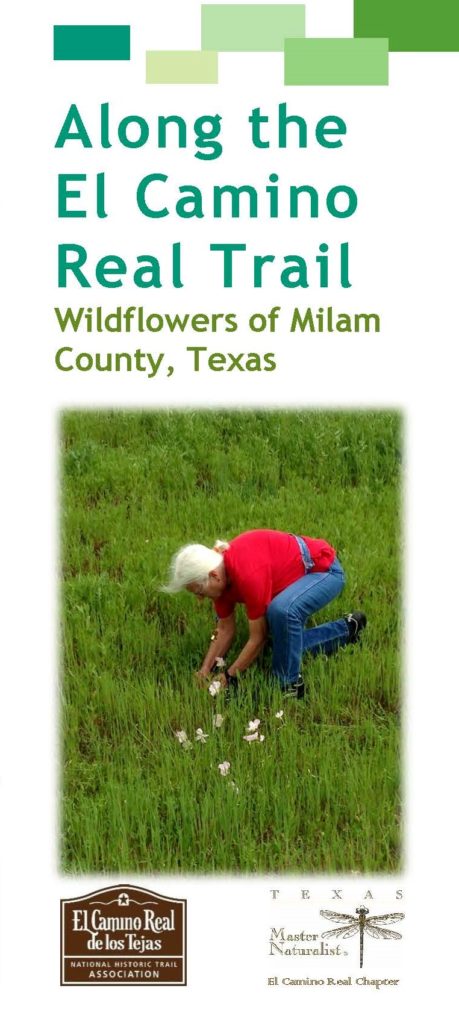
3. Books, Files and Websites from our TMN classes, and other TMN sites:
- Our Chapter’s comprehensive spreadsheet (xlsx) of Native Plant Lists
See 288 species and where they have been located in the county. - Forages.tamu.edu. At this site you will be able to read or download forage-related publications that will help with forage species selection, establishment, management, and utilization. There is information on soil fertility, grazing management, incorporating legumes into your forage system, and minimizing winter feeding costs. You will also find information about our Pasture & Livestock Management Workshop for Novices, how to manage forage pests, information about upcoming events, and links to other sites you will hopefully find useful.
- Native Plant Finder Find native plants, and specific plants for Butterflies, based on your zipcode.
- Aquaplant.tamu.edu a pond management diagnostic tool.
- Texasinvasives.org “Hello invasive species, goodbye Texas”
- University of Texas Into to Flora of Central Texas online course, and their archive of identification photos.
- Threatened or endangered species of plants in Texas, per Federal or State classification.
- Marilyn McBroom Knight’s identification guide for yellow asters from Knight’s Facebook page, made into a two page chart. Aster ID Guide Pg1, Aster ID Guide Pg 2
- Over 200 Brazos Valley Wildflowers, by Dwight Bohlmeyer. Includes beautiful photos and all Family, Species and Common names.
- Excellent wildflower photos from Flicker’s Texas Wildflower Group
- Support the Botanical Research Institute of Texas (BRIT) by transcribing historic herbarium worksheets into their digital database. https://brit.org/transcription and their main site https://brit.org/ and a brief instruction sheet Citizen Science Transcribing Selections
- Botany Word of the Day, every day a new plant is shown and hovering over it reveals an education on biology terminology. And clicking the image brings up a complete explanation. Really neat.
- Biology and Wildlife for landowners, by Texas NRCS conservation service.
- The Revershon Naturalist Newletters, Texas NRCS.
- Blackland Research & Extension Center, Temple
- Plant Identification Handout, by Mike Mitchell
- AgriLife’s TEXNAT Database – Nat’l Resource Mgmt of TX Rangelands
- East TX TMN Chapter, Plants of Smith County, Herbarium
- American Journal of Botany
- San Marcos River Foundation
- Nuisance Aquatic Vegetation
- Online Rangeland Plants of Texas, Database
- Invasive Species that should be Avoided
- Native Plant Society of Texas web site
- Book “San Marcos River Story”
- Book (New!) Brush and Weeds of Texas Rangeland, Barron Rector, et al.
- Book “Tales of a Shaman’s Apprentice”
- Book “The World Without Us”
- Some Common Family Characteristics of Plants from Ricky Linex, NRCS.
- Centuries-Old Plant Collection Now Online — A Treasure Trove For Researchers
- S. M. Tracy Herbarium, Texas Grasses
- Book: “Vascular Plant Taxonomy”
- Book: “Manual of the Vascular Plants”
- Book: “Wild Orchids of Texas”
- Book: “Aquatic and Wetland Plants of the Southwestern US”
- Book: “Texas Wildflowers”
- Book: “Plants of the Texas Coastal Bend”
- University of Texas at Austin Plant Resources Center offers searchable databases, flora, and herbarium specimen images. Can search this database by county.
- USDA Plants Database is a searchable database using either common or scientific names. Has lots of images of flowers, whole plants, and, in some cases, fruits and seeds.
- Texas A&M University Vascular Plant Image Library. Great images of species. I use this to verify any IDs I make.
- The Families of Flowering Plants: Descriptions, Illustrations, Identification, and Information Retrieval. This is a new discovery of mine. I’ve used it a couple of times and it’s been pretty good. It contains an interactive key, character list, illustrations, full and partial descriptions, diagnostic descriptions, differences and similarities between taxa, lists of taxa exhibiting specified attributes, summaries of attributes within groups of taxa, geographical distribution, genera included in each family, classifications (Dahlgren; Dahlgren, Clifford, and Yeo; Cronquist; APG), notes on the APG classification, poems, acknowledgements, references, contacts, conditions of use, contributions.
- Know your (Texas) Grasses, by Barron Rector, Agrilife Bookstore.
- Brush and Weeds of Texas
- Noble Foundation Plant Image Gallery
- Pat Bales Plant Site
- Native Plants of South Texas
- Brush Busters
4. Shawn Walton’s Blog / Weekly Newspaper Column:
- 06.22.09_Native Orchids
- 06.29.09_Native Grasses
- 08.31.09_Edible Wild Plants
- 09.14.09_Blue Grama
- 12.09.09_Mistletoe
- 03.03.10_Wildflowers
- 04.20.10_Wildflower Week
- 06.16.10_Poison Ivy
- 10.07.10_Allergies
- 11.04.10_Microgreens
- 11.25.10_Tree Leaves
- 12.09.10_Poinsettias
- 12.16.10_Live Christmas Trees
- 01.13.11_Onions
- 01.20.11_gingko tree
- 01.27.11_Blackberries
- 02.24.11_Landscaping Zones
- 04.28.11_Molasses
- 05.12.11_Herbs



